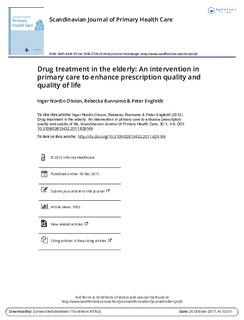| dc.contributor.author | Olsson, Inger Nordin | |
| dc.contributor.author | Runnamo, Rebecka | |
| dc.contributor.author | Engfeldt, Peter | |
| dc.date.accessioned | 2017-06-07T12:40:56Z | |
| dc.date.available | 2017-06-07T12:40:56Z | |
| dc.date.issued | 2012 | |
| dc.identifier.citation | Olsson, I.N., Runnamo, R. & Engfeldt, P. (2012) Drug treatment in the elderly: an intervention in primary care to enhance prescription quality and quality of life. Scandinavian Journal of Primary Health Care, 30(1), s. 3-9. | |
| dc.identifier.uri | http://hdl.handle.net/11250/2445148 | |
| dc.description | Randomisert kontrollert studie hvor det undersøkes om legemiddelgjennomgang og tilrettelegging for pasientmedvirkning har effekt på foreskrivingskvalitet og livskvalitet. | |
| dc.description.abstract | Objective: the aim of the study was to assess the effect on prescription quality and quality of life after intervention with prescription reviews and promotion of patient participation in primary care. Design: a randomized controlled study with three groups: (A) controls, (B) prescription review sent to physician, and (C) as in B and with a current comprehensive medication record sent to the patient. Setting: the municipality of Örebro, Sweden (130 000 inhabitants). Intervention: the study focused on the easiest possible intervention to increase prescription quality and thereby increase quality of life. The intervention should be cost-efficient, focus on colleague-to-colleague advice, and be possible to perform in the primary health care centre without additional resources such as a pharmacist. Subjects: 150 patients recently discharged from hospital. Inclusion criteria were: 75 years, five drugs and living in ordinary homes. Main outcome measures: quality of life (EQ-5D index, EQ VAS) and quality of prescriptions. Results: extreme polypharmacy was common and persistent in all three groups and this was accompanied by an unchanged frequency of drug-risk indicators. There was a low EQ-5D index and EQ VAS in all three groups throughout the study. No statistically significant differences were found anywhere between the groups. Conclusion: the intervention seems to have had no effect on quality of prescriptions or quality of life. This underlines the major challenge of finding new strategies for improving prescription quality to improve patient outcome measures such as quality of life and reduce the known risks of polypharmacy for the elderly. | |
| dc.language.iso | eng | |
| dc.rights | Navngivelse-Ikkekommersiell 4.0 Internasjonal | |
| dc.rights.uri | http://creativecommons.org/licenses/by-nc/4.0/deed.no | |
| dc.subject | pasientsikkerhet | |
| dc.subject | legemiddel | |
| dc.subject | legemiddelbruk | |
| dc.subject | legemiddelgjennomgang | |
| dc.subject | legemiddelforskrivning | |
| dc.subject | uhensiktsmessig legemiddelbruk | |
| dc.subject | legemiddelrelaterte problemer | |
| dc.subject | legemiddelliste | |
| dc.subject | allmennmedisin | |
| dc.subject | allmennpraksis | |
| dc.subject | eldre | |
| dc.subject | skrøpelige eldre | |
| dc.subject | randomisert kontrollert studie | |
| dc.subject | intervensjon | |
| dc.subject | pasientdeltakelse | |
| dc.subject | brukermedvirkning | |
| dc.subject | livskvalitet | |
| dc.subject | Sverige | |
| dc.title | Drug treatment in the elderly: an intervention in primary care to enhance prescription quality and quality of life | |
| dc.type | Journal article | |
| dc.type | Peer reviewed | |
| dc.rights.holder | Olsson, Inger Nordin | |
| dc.source.volume | 30 | |
| dc.source.journal | Scandinavian Journal of Primary Health Care | |
| dc.source.issue | 1 | |
| dc.identifier.doi | 10.3109/02813432.2011.629149 | |

